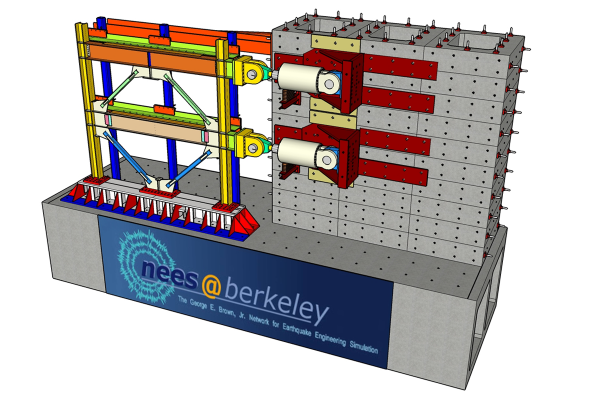OpenSees
OpenSees [L1 ], the Open System for Earthquake Engineering Simulation, is an object-oriented, open source software framework. It allows users to create both serial and parallel finite element computer applications for simulating the response of structural and geotechnical systems subjected to earthquakes and other hazards. OpenSees is primarily written in C++ and uses several Fortran and C numerical libraries for linear equation solving, and material and element routines.
Users of OpenSees create applications by writing scripts in the Tcl programming language. The TclModelBuilder class in the OpenSees framework extends an instance of the Tcl interpreter with commands for finite element model building and analysis.
See: [L2 ]: Real-Time Interface for Numerical Simulation in OpenSees

OpenSees can be used in conjunction with OpenFresco (the Open-source Framework for Experimental Setup and Control), an environment-independent software framework, that connects finite element models with control and data acquisition systems in laboratories to facilitate hybrid simulation of structural and geotechnical systems.
The OpenFresco interpreter adds commands to Tcl to create the objects needed to conduct a hybrid simulation, such as experimental elements, experimental sites, experimental setups and experimental controls. Each of these commands is associated (bound) with a C++ procedure in OpenFresco.
OpenFresco can be used as middleware to provide data to numerical processors such as OpenSees, either from virtual simulators or direct from controllers/sensors connected to real systems.
OpenFrescoExpress is a simplified version of the OpenFresco middleware software that can be used for projects involving only one or two actuators, meaning one or two degrees of freedom. One of the useful features of OpenFrescoExpress is its Tk Graphical User Interface (GUI) with a built-in help functionality. Through this GUI users can easily:
- Create a simple structural model with the desired mass, stiffness and energy dissipation properties by selecting from one of three template structures.
- Load any ground motion from the PEER ground-motion database or the CSMIP database and generate pseudo acceleration and displacement spectra.
- Setup an initial displacement condition to perform a free vibration test (and evaluate the effect of experimental errors on the response).
- Chose to connect to real laboratory controllers, actuators and data acquisition systems or simulate the behavior of the test specimen to perform dry-runs and/or learn about hybrid simulation.
- Watch the progress of the hybrid simulation in real time including graphs plotting the structural response at each degree of freedom (displacements, accelerations & forces) and error monitors tracking the accuracy of the test.
